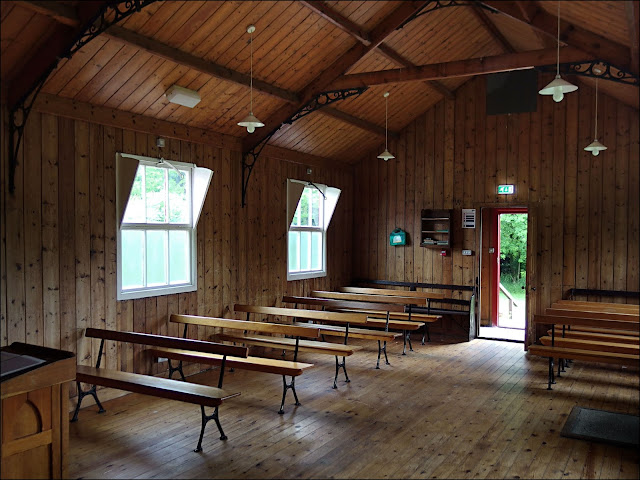Those of you who read these ramblings regularly will know that I am particularly fascinated by old churches, not through any deep religious conviction but because they are resistant to the constant changes which afflict many of our buildings. Also they reflect the quality of craftsmanship which our ancestors were capable of when they put their minds to it.
The Museum Of East Anglian Life have not managed to import a village church to their site - not so far anyway - but there is this simple non-conformist chapel, so typical of the many which sprang up across East Anglia during the nineteenth century. The museum calls it "the tin tabernacle" as the walls and roof are made of corrugated iron sheets. They rescued the building from the village of Great Moulton where it had stood since 1890.
The chapel was originally supplied as pre-fabricated, flat-pack units by Boulton And Paul, the Norwich firm who had started out as an ironmonger's shop. This must have been one of their first forays into the pre-fabricated buildings market, a field in which they made their mark during WWI, when the military had an insatiable appetite for such constructions. They also manufactured aircraft bodies, notably the Sopwith Camel.
Inside the walls and ceilings were clad with wooden boards and there was also a wooden floor. The reason that the architecture is lacking any structural features (pointed windows or doors, for example) which you might expect in even a rudimentary church building, is that these units were designed so that they could also be used as village halls or small schools.
As well as services for the adult community there would of course have been a Sunday School for the children, as these little chairs, gathered around the harmonium, testify.
The village where I grew up was too small to even support a Sunday school and the old chapel had long stood unused and neglected. However I still have in my possession a Bible which was presented to my father, "aged 9 yrs", in 1933. I asked him about it once and all he could remember was that the preacher used to shout a lot. He couldn't recall what he learned there or indeed how he'd managed to win a prize, "I don't s'pose it did us any harm though", he added.






I absolutely love this chapel John and cannot help imagining what the noise would be like if there was a thunder storm with torrential rain during a service. I also love the hard and unyielding benches - no slouching in those times was there?
ReplyDeleteHi John - lovely to see this ... I owned a little similar building (as a house) to this in Johannesburg ... it and others were built for workers - in Jhb for the railway workers, out in the Eastern Transvaal for the mining community ... having lived in one - it brings back lots of memories ... tin rooves in hailstorms, nothing to purchase onto in walls ... I was quite glad to leave before disaster struck! I looked up Boulton and Paul and wondered if they'd shipped these sorts of prefabs to SA ... that they didn't show .. cheers Hilary
ReplyDeleteI've been inside this chapel on one of my visits to the Museum. Our local URC church started out in one of these tin tabernacles too though it's long gone and been replaced by a very upmarket church and church hall now. I love the fact that all your dad remembered of church services was that the preacher shouted a lot! :):)
ReplyDeleteWhat a great little church with such rich history. I love the inside look, nothing fancy but has everything it needs to be useful to the community.
ReplyDeletewow I like your wood chapel veery much.
ReplyDeleteSuch a utilitarian building which made perfect sense for the time and place. I love all the wood.
ReplyDeleteThe history of theses churches is so interesting
ReplyDeleteI like this small church for its simple but lovely appearance, the feel of warmth inside made of wood, and “the quality of craftsmanship which our ancestors were capable of when they put their minds to it” as you wrote.
ReplyDeleteYoko
Now that would be a church I'd feel comfortable in although I'd need a cushion to sit on those hard wood benches. Pre-fabricated, flat-pack units where you can build your own eh? I'm going to check on Amazon.com and order one; free shipping on orders over $49 too.
ReplyDeleteSuch a beautifully constructed building. Love that interior.
ReplyDeleteIt looks like something that would spring up in rural areas of the U.S. today.
ReplyDeleteWhat a beautiful chapel, the interior is especially attractive. That wood floor, the chairs around the harmonium. I attend a church in a building that is an auditorium, custom built for the church. It lacks the charm but is filled with spirit.
ReplyDeleteNot fancy, John, but it works!
ReplyDeleteI like these photos! Such simple, serene looking decor.
ReplyDelete"I don't s'pose it did us any harm though", he added.
This made me laugh! Hey, if that's the worst thing you can say about the place, that's pretty good.
A church siding of corrugated iron -- fascinating. I believe that corrugated iron was only used for a short period before it was switched over to corrugated steel. Such a wonderful little chapel!
ReplyDeleteSuch a lovely surprise to see the inside softened by the wood paneling John, makes all the difference! I can see how a construction like this would be well used.
ReplyDeleteI would be fascinated by the old chapels also. We don't have many of them here. The new churches are different. I would stop by this old chapel and spend time for a while there.
ReplyDeleteGreat pictures and interesting post!
There is much to say for the principle of "Keep it simple"
ReplyDeleteReally interesant little church. It looks simply but beautiful.
ReplyDelete